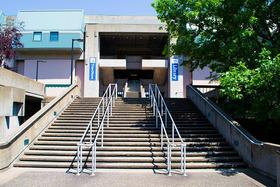- Sacramento City College is an open-access, comprehensive community college, serving a diverse student population. We provide a wide range of educational opportunities and support services leading to transfer, career advancement, basic skills development, and personal enrichment. Through these efforts, we contribute to the intellectual, cultural, and economic vitality of the community.
School Highlights
Sacramento City College serves 28,021 students (17% of students are full-time).
The college's student-teacher ratio of 37:1 is higher than the state community college average of 32:1.
Minority enrollment is 72% of the student body (majority Hispanic), which is less than the state average of 77%.
Quick Facts (2025-26)
- Enrollment: 28,021 students
- In-state tuition: $1,104
- Out-state tuition: $7,272
- Student-teacher ratio: 37:1
- Minority enrollment: 72%
- Source: Integrated Postsecondary Education Data System (IPEDS)
Top Rankings
Sacramento City College ranks among the top 20% of public schools in California for:
School Overview
The teacher population of 748 teachers has stayed relatively flat over five years.
Sacramento City College
(CA) Community College Avg.
Carnegie Classification
Associate's Colleges: Mixed Transfer/Career & Technical-High Traditional
Baccalaureate/Associate's Colleges: Associate's Dominant
Institution Level
At least 2 but less than 4 years
At least 2 but less than 4 years
Institution Control
Public
Public
Total Faculty
748 staff
315 staff
School Calendar
Student Body
The student population of Sacramento City College has grown by 34% over five years.
The student-teacher ratio of 37:1 has increased from 27:1 over five years.
The Sacramento City College diversity score of 0.78 is more than the state average of 0.70. The school's diversity has stayed relatively flat over five years.
Total Enrollment
28,021 students
9,796 students
Student-Teacher Ratio
37:1
32:1
# Full-Time Students
4,774 students
1,259 students
# Part-Time Students
23,247 students
8,537 students
# Enrollment Undergraduate
280 students
242 students
# Full-Time Undergraduate Students
4,774 students
1,250 students
# Full-Time Graduate Students
n/a
63 students
# Part-Time Undergraduate Students
23,247 students
8,299 students
# Part-Time Graduate Students
n/a
10 students
Total Dormitory Capacity
n/a
121 students
% American Indian/Alaskan
n/a
n/a
% Asian
16%
13%
% Hispanic
31%
47%
% Black
9%
7%
% White
28%
23%
% Hawaiian
1%
1%
% Two or more races
6%
5%
% Non Resident races
n/a
1%
% Unknown races
7%
3%
Diversity Score
0.78
0.70
College Completion Rate (Students who graduate in less than 4 years)
26%
42%
College Completion Rate (Students who graduate in 4 years or more than 4 years)
n/a
43%
Average Graduate Earnings (10 Years)
$36,800
$34,700
Tuition and Acceptance Rate
The public in-state tuition of $1,104 is less than the state average of $1,516. The in-state tuition has declined by 14% over four years.
The public out-state tuition of $7,272 is more than the state average of $6,779. The out-state tuition has declined by 25% over four years.
In-State Tuition Fees
$1,104
$1,516
Out-State Tuition Fees
$7,272
$6,779
Tuition Notes
$46 per unit
% Students Receiving Some Financial Aid
91%
85%
Median Debt for Graduates
$10,500
$10,500
Median Debt for Dropouts
$8,166
$6,239
Acceptance Rate
n/a
93%
Source: 2024 (or latest year available) Integrated Postsecondary Education Data System (IPEDS) , School Administrators
School Notes
- Sacramento City College, part of the Los Rios Community College District, provides educational opportunities for nearly 22,000 students at the college and its three outreach centers. Classes are offered to California residents at a tremendous savings over four-year colleges, universities, and trade schools. And SCC is a leader in providing lower division programs that prepare students for successful transfer. We also offer occupational programs that meet the current needs of business and industry. With its many redwood and pine trees, ivy-covered walkways, and mix of classic and modern architecture, Sacramento City College has the look and feel of a traditional university. The purpose of Sacramento City College is to provide academic, training, and social opportunities where critical thinking and critical skills are developed. The college is responsive to the emerging educational needs of the community. The college is a resource for the community, the economic evolution of the community, and a portal to the global marketplace. To implement its philosophical commitments and purpose, the college provides a variety of programs, which include General Education, Occupational Education, Developmental and Basic Skills Education and Distance Education. Sacramento City College is officially accredited by the Western Association of Schools and Colleges. The University of California and all other accredited colleges and universities give full credit for appropriate courses completed at Sacramento City College.
- Sample of notable school alumni/alumnae:
- Joan Didion, author, attended in the 1950s. -
Frequently Asked Questions
How much does Sacramento City College cost?
Sacramento City College's tuition is approximately $1,104 for In-State students and $7,272 for Out-State students.
What schools are Sacramento City College often compared to?
Sacramento City Collegeis often viewed alongside schools like American River College by visitors of our site.
Who are famous alumni from Sacramento City College?
Sacramento City College famous alumni include: Joan Didion, author, attended in the 1950s..
What is Sacramento City College's ranking?
Sacramento City College ranks among the top 20% of community college in California for: Diversity in US community colleges and Largest student body.
In what neighborhood is Sacramento City College located?
Sacramento City College is located in the Southeastern Sacramento neighborhood of Sacramento, CA.
Recent Articles

Student Success Programs That Actually Work at Community Colleges
Discover evidence-based student success programs at community colleges for 2025, with outcomes, examples, and actionable strategies.

Best Community Colleges by Career Path in 2025
Explore top community colleges for career-training programs in 2025, including healthcare, IT, skilled trades and business pathways.

Dual Enrollment in High School: Benefits, Risks & Real Student Results
Explore the pros and cons of dual enrollment in high school, real outcomes for students in 2025, and how to decide if it’s right for you.









